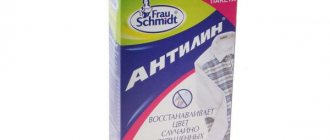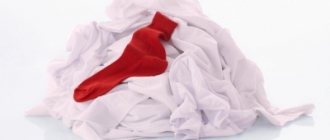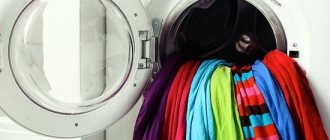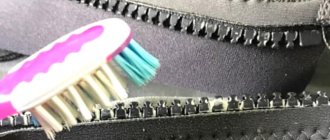An unpleasant surprise is the staining of white items after washing. Most often this happens because colored clothes were accidentally loaded into the washing machine drum.
You should not despair, as there are many ways to regain lost whiteness.
What to do if white clothes are dyed during washing, how to restore the color, how to bleach and save things? Details are in the article.
First aid
For the whitening procedure to be effective, you need to start it immediately. Waiting for the item to dry is not recommended, as this will complicate the task.
Here's what you need to do first:
Find the “culprit” of the incident. The dyed item must be removed.- Wash the faded linen again using powder.
- White linen should be washed in hot water (the maximum allowable value for a particular item).
- Use oxygen bleach to wash whites.
Under no circumstances should you iron faded fabric! This will lead to the “sealing” of the pigment in its fibers. It will be impossible to remove the paint.
Preliminary testing
Before returning any items to white, determine the texture of the fabric. Sort natural and synthetic items separately. Then study the labels on the clothes, these are the best care instructions.
Use the same division of fabrics according to structure for washing. If you do not mix synthetics, knitwear and cotton in the drum of a machine, the whiteness of things will remain longer.
Important! Wash white items not only separately from colored items, but also sort them by quality. Do not use powders for colored laundry!
So, we sorted out the quality. Now inspect your items for stains. If there are particularly strong stains, you will have to work with them separately, and only then begin to restore the freshness of the color. If there are no individual stains on the fabric, choose one of the methods described below.
How to restore whiteness to laundry at home?
You can restore lost whiteness using folk remedies . If they are powerless, then you should use professional bleaches.
White things shed differently. Sometimes colored stains or spots appear on them, and sometimes they are completely painted in gray, pink or another shade.
In the first case, local treatment of the problem area is sufficient, and in the second, complete soaking is required.
How to whiten with folk remedies?
White items that have faded after washing can be restored using available products. Most often they are used according to a single scheme: “preparing the solution → soaking → washing as usual.”
The most effective means at hand that have a whitening effect:
Baking soda . To prepare the solution you will need 5 liters of water and 6 tbsp. l. soda Soak things in the resulting solution for 4 hours.- Laundry soap . It is grated and completely dissolved in water. The laundry is soaked in the solution for 1-2 hours.
- Vinegar. Dissolve 100 g of table vinegar in 6 liters of water. Clothes are soaked for 6 hours.
- Turpentine. For 5 liters of water you will need 5 tbsp. l. turpentine. The item is soaked in the resulting solution for 3 hours.
- Hydrogen peroxide . For 5 liters of water you will need 150 ml of liquid pharmaceutical antiseptic. The item is left in the solution for 3 hours. Peroxide is convenient to use for local stain removal. It is applied to a cotton pad and the problem area is treated.
- Ammonia. For 5 liters of water you will need 1 tbsp. l. alcohol The item is soaked for an hour.
- Starch and lemon juice . They are mixed in such a way that a thick paste is obtained. It is applied to the fabric and left to act for 12 hours.
- Potassium permanganate. Several potassium permanganate granules need to be completely dissolved in warm water. The water should be pinkish. The holding time is 2 hours.
- Lemon acid . Dissolve 2 tbsp in 5 liters of water. l. powder. Things are soaked for 2 hours.
- Aspirin. 5 tablets are dissolved in 5 liters of water. They must first be crushed into powder. Things are soaked in the solution for 8 hours.
- Mustard. Dissolve 5 tbsp in 5 liters of water. l. mustard powder. Things are soaked for 2 hours.
- Lemon juice . It is applied to the stain in its pure form. The exposure time is 2 hours. This product is used to remove local stains.
- Boric acid (alcohol solution 3%) . Dissolve 2 tbsp in 3 liters of water. l. acids. Things are soaked for 60 minutes.
- Tooth powder or white clay without additives . The selected composition is diluted with water until a thick paste is obtained. It is applied to the stain, left for 30 minutes, after which the laundry is washed as usual.
If the result of bleaching is unsatisfactory, then the item can be boiled.
Before starting the procedure, you need to make sure that the fabric can withstand exposure to high temperatures. To do this, study the information indicated on the product label.
white things correctly
take a large enamel pan, fill it with water (the container should be clean and without signs of rust);- 1 kg of laundry will require 10 liters of water;
- heat water, dissolve 250 g of liquid laundry soap and the same amount of soda in it;
- put the laundry in water and leave it to boil;
- Things need to be stirred periodically;
- Recommended cooking time is 1-1.5 hours.
After boiling, the water is drained, the laundry is cooled and rinsed in cool water.
How to save things using household chemicals?
Faded items can be washed using bleach. Scheme of their use:
- dissolve the composition in water;
- soak clothes;
- wash as usual.
Depending on the chosen composition, its dosage and exposure time will differ.
Top 3 effective remedies:
Antiline by Frau Schmidt .
This bleach and stain remover is sold in tablets. For a pack of 10 pieces you will have to pay about 230 rubles. You can buy 2 tablets for 60 rubles. To process 1 kg of laundry, 1 piece is enough. It is dissolved in 10 liters of water (temperature from 30 to 60 degrees), washing powder is not required. After an hour, the items are rinsed and normal washing begins.- Vanish Gold crystal white . To remove stains, it is better to purchase a gel. For a 0.45 liter package you will need to pay about 150 rubles. Dissolve 1 cap of detergent (60 ml) in 5 liters of water. Soaking time – up to 6 hours.
- Organic bleach Sodasan . The liquid concentrate does not contain chlorine. Its cost is 470 rubles. The product is applied to the stains and left to act for 30-60 minutes. Then wash the clothes in a machine, to which 30 ml of bleach is added.
It is not recommended to use compositions containing chlorine as bleaching agents. This substance has an aggressive effect on tissues, promoting the destruction of their fibers.
Therefore, preference is given to modern household chemicals containing active oxygen. Such compositions are effective even at low water temperatures.
The video will tell you how to save faded white clothes using BOS powder:
Whitening with improvised means
White bedding is first of all very beautiful, but in practice it turns out to be quite impractical. Since it gets dirty very quickly, the slightest stains are visible on it, and also, over time, it acquires a gray tint.
If you decide to restore your former shining whiteness at home, but don’t have any special chemicals at home, you can use products that can be found in any home.
Below are the most popular whitening methods:
- Using boric acid.
The first stage is soaking, as a rule, most washing machines have a soaking function. Pour two tablespoons of boric acid into the drum along with the laundry, and then start the program. After its completion, turn on the longest cycle at a temperature of at least 60 degrees. In order to wash as well as possible, turn on an extra rinse. - Soda is a budget-friendly cleaning method and, above all, it will clean your machine of deposits on the heating element. Pour 100 grams of soda and the powder into the powder loading compartment. Start the cotton program at sixty degrees. After the cycle is completed, the item will be as good as new.
This product can also be used for children's underwear, since it is absolutely safe and does not cause allergic reactions. Supermarkets also sell special washing soda, but its cost is significantly different from baking soda, although the mechanism of action is almost identical.
- Using tableted hydroperite. Place two tablets in the drum along with the soiled items, add laundry detergent and run the SMA. To improve the cleaning of your laundry, install an extra rinse.
- The cheap pharmaceutical drug aspirin. Load the product into the drum, take 10 aspirin tablets, crush them and add them there. Set the cycle to suit your fabric type.
- How to properly bleach laundry in a washing machine using blue dye? Blue does not have a whitening effect, but rather a tinting effect. The mechanism is as follows: dilute the blue in a one-to-one ratio with water. Pour the resulting composition into the rinse aid hole, and at the end of the cycle you will receive clean laundry with a slightly bluish tint.
How to return color to different types of fabric?
Depending on the type of fabric, priority bleaching methods will differ:
Cotton and linen items are not afraid of high temperatures, so they can be boiled. They are resistant to various types of bleaches, including chlorine. However, exposure time should be kept to a minimum.- Synthetic underwear is durable and wear-resistant, but does not tolerate contact with aggressive agents.
Therefore, preference should be given to gentle bleaches and folk remedies. You can use aspirin, laundry soap, lemon juice, soda, and ammonia. The maximum water temperature is 60 degrees. - Printed items should not be soaked in caustic substances. If such fabric has faded, then it must be handled carefully, trying not to get on the printed image.
- Snow-white satin should be washed in warm water (up to 40 degrees). It is not recommended to rub the fabric. The best bleaching agent is vinegar or oxygen stain remover.
- Woolen fabrics are treated only with liquid stain removers.
The more delicate the fabric, the more gentle the bleaching agents should be.
Chlorine almighty
Chlorine bleaches work great on natural white fabrics. Soaking in “Whiteness” guarantees results, although it greatly affects the structure of the thread. To revive washed sheets and towels, dissolve 2 caps of “Whiteness” in 10 liters of water, immerse the linen in the hot solution and wait until it cools. Afterwards, rinse thoroughly and dry the laundry outside to eliminate the chlorine smell.
Important! NEVER use chlorine bleach on items with trim or colored inserts, or on synthetic materials!
How to prevent re-staining?
White items change their original color due to non-compliance with washing rules. To avoid this problem again after the whitening procedure, you need to adhere to several rules:
- Do not wash white and colored linen together;
- do not wash old and new items together - even if a recently purchased item has a small colored insert, it may fade;
- rinse the laundry thoroughly after washing;
- Do not dry things on heating devices or in the sun. Because of this, they may turn yellow.
If it is impossible to avoid washing white and black items together, then you need to use color-catching napkins (Chameleon, Dr. Beckmann and others). Their average cost is 300 rubles.
You can learn how to prevent shedding and save faded white things from this article.
How to bleach items that have faded during washing
To successfully bleach an item that has been dyed during washing, you must use any bleaching method, the main thing is to do this while the item is still wet after an unsuccessful wash.
There are bleaches on sale specifically for accidentally dyed fabrics.
It happens that you can’t bleach an item the first time. In this case, the procedure must be repeated if the instructions for the product used allow this.
If there are no special products at hand, then the easiest way to try to bleach things made of cotton and linen is with laundry soap:
- Generously rub the wet item with laundry soap.
- Leave for at least 6 hours. In summer, you can put the item in the sun - this will have a better effect.
- Rinse thoroughly and wash.
For silk and wool, in this case, the bleaching described above using mustard or the use of special products for delicate fabrics is suitable.
It is better to bleach delicate fabrics with special means
Video: how to bleach laundry
Important Tips
To prevent the bleaching process from causing even more damage to white items, you must take into account the following tips:
Follow the manufacturer's recommendations indicated on the label.- Try a new product on an inconspicuous area and monitor the tissue's reaction.
- Observe the dosage of the bleaching agent.
- Strictly follow the instructions for using the stain remover; do not leave things in it for longer than the time specified in the instructions.
- After washing, dry things properly, do not hang white and colored items on top of each other, and do not fasten them with one clothespin.
When working with aggressive compounds, you need to protect your hands with gloves and your respiratory system with a mask or respirator.
What types of bleaches are there?
Is it possible to return whiteness to things that have lost it over time, and how to do this? The simplest and most modern method of treating white fabric to return color is the use of industrial chemical bleaches, which are divided into three types:
- Oxygen-containing bleaches;
- Chlorine-containing;
- Optical brighteners.
Oxygen-containing bleaches are suitable for all types of white fabrics. Most effective in cool water.
Chlorine bleaches are quite aggressive. Applicable only to cotton and linen fabrics.
Optical brighteners give white items a snow-white appearance by depositing optical crystals onto fabric fibers.
Cannot be used on products with colored inserts or designs.
How to safely bleach gray baby underwear
Children's underwear is a special category of things that receive close attention when washing. In the first three years of a child’s life, washing clothes with ordinary powder and using chemical bleaches is prohibited. This may lead to allergic reactions. It is better to choose affordable and safe folk remedies:
- Soda.
- Hydrogen peroxide.
- Ammonia.
- Baby soap.
- Potassium permanganate.
- Lemon acid.
- Laundry soap.
- Salt.
These substances help cope with dirt and get rid of grayness or yellowness. If used correctly, they will not harm the child’s health, which means parents will not have to worry. The principle of use is extremely simple. Soak baby clothes in the chosen product for two to three hours, then rinse well and wash as necessary with baby powder.











